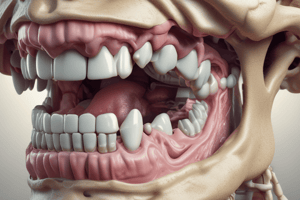Podcast
Questions and Answers
What is a characteristic radiographic feature of Fibrous Dysplasia?
What is a characteristic radiographic feature of Fibrous Dysplasia?
- Ground-glass opacity with intact cortex (correct)
- Unilocular radiolucent lesion with root resorption
- Multilocular radiopacity with calcified foci
- Well-defined corticated radiolucent area
How does an Ossifying Fibroma typically present in radiographs?
How does an Ossifying Fibroma typically present in radiographs?
- Multilocular radiopacity with no calcified components
- Corticated radiolucent area with root resorption
- Ground-glass opacity with cortical expansion
- Well-defined, unilocular to multilocular radiolucent lesion (correct)
What might you observe in the surrounding structures of fibro-osseous lesions?
What might you observe in the surrounding structures of fibro-osseous lesions?
- Thickening of cortical bone without displacement
- Displacement of teeth and cortical bone expansion (correct)
- No changes in the adjacent teeth or bone
- Uniform bone density around the lesion
Which of the following is an essential consideration for diagnosing fibro-osseous lesions?
Which of the following is an essential consideration for diagnosing fibro-osseous lesions?
What type of radiographic appearance is typical for Cemento-Ossifying Fibroma?
What type of radiographic appearance is typical for Cemento-Ossifying Fibroma?
Study Notes
Radiographic Features of Fibro-Osseous Jaw Lesions
-
Definition: Fibro-osseous lesions are a group of conditions characterized by the replacement of normal bone with fibrous tissue and varying degrees of calcification.
-
Common Types:
- Fibrous Dysplasia
- Ossifying Fibroma
- Cemento-Ossifying Fibroma
-
Radiographic Appearance:
-
Fibrous Dysplasia:
- Often appears as a radiolucent lesion that can be unilocular or multilocular.
- Characteristic "ground-glass" opacity; the cortex may be expanded but remains intact.
-
Ossifying Fibroma:
- Generally presents as a well-defined, unilocular to multilocular radiolucent lesion.
- May have varying degrees of radiopacity as it matures, showing the presence of calcified components.
-
Cemento-Ossifying Fibroma:
- Can appear as a well-defined, corticated radiolucent area.
- Often exhibits characteristic radiopaque foci that become more pronounced with age.
-
-
Surrounding Structures:
- Lesions may cause displacement of teeth and cortical bone expansion.
- Teeth may deviate or show root resorption in the presence of aggressive tumors.
-
Size and Location:
- Typically found in the mandibular region, particularly in the premolar/molar area, but may also occur in maxilla.
- Range in size from small (a few millimeters) to large (several centimeters).
-
Variability:
- Radiographic features may vary significantly based on the lesion's maturity and type.
- Importance of correlating imaging findings with clinical presentation for accurate diagnosis.
-
Diagnosis:
- Differential diagnosis includes various other conditions that can mimic fibro-osseous lesions: keratocystic odontogenic tumors, odontogenic tumors, or other cysts.
Fibro-Osseous Jaw Lesions
- Characterized by normal bone replacement with fibrous tissues, varying calcification levels.
- Common types include:
- Fibrous Dysplasia
- Ossifying Fibroma
- Cemento-Ossifying Fibroma
Fibrous Dysplasia
- Often presents as radiolucent lesions; can be unilocular or multilocular.
- Distinctive "ground-glass" opacity visible on radiographs.
- Cortical expansion, but bone integrity remains intact.
Ossifying Fibroma
- Usually well-defined, unilocular to multilocular radiolucent lesions.
- Variable radiopacities as it matures, indicating calcified components.
Cemento-Ossifying Fibroma
- Distinguishable as well-defined, corticated radiolucent area.
- Often exhibits distinctive radiopaque foci, becoming more pronounced with age.
Radiographic Features
- Lesions may cause tooth displacement and cortical bone expansion.
- Teeth may deviate or experience root resorption in aggressive tumor cases.
- Primarily found in the mandible, specifically the premolar/molar area, but can also appear in the maxilla.
- Size varies from a few millimeters to several centimeters.
- Radiographic features can differ greatly depending on the lesion's maturity and type.
- Correlating imaging results with clinical presentation is crucial for accurate diagnosis.
Diagnosis
- Requires differentiation from other conditions mimicking fibro-osseous lesions, including:
- Keratocystic odontogenic tumors
- Odontogenic tumors
- Other cysts
Studying That Suits You
Use AI to generate personalized quizzes and flashcards to suit your learning preferences.
Description
Explore the characteristics and radiographic features of various fibro-osseous jaw lesions including Fibrous Dysplasia, Ossifying Fibroma, and Cemento-Ossifying Fibroma. This quiz will test your knowledge on their appearances and definitions, helping you differentiate between these conditions effectively.




